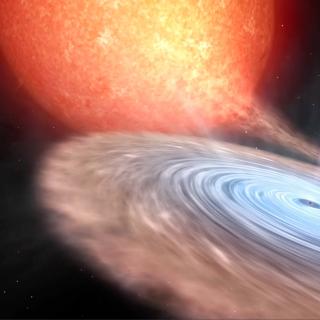Bibcode
Ibrahim, A. Y.; Borghese, A.; Rea, N.; Zelati, F. Coti; Parent, E.; Russell, T. D.; Ascenzi, S.; Sathyaprakash, R.; Götz, D.; Mereghetti, S.; Topinka, M.; Rigoselli, M.; Savchenko, V.; Campana, S.; Israel, G. L.; Tiengo, A.; Perna, R.; Turolla, R.; Zane, S.; Esposito, P.; Castillo, G. A. Rodríguez; Graber, V.; Possenti, A.; Dehman, C.; Ronchi, M.; Loru, S.
Referencia bibliográfica
The Astrophysical Journal
Fecha de publicación:
1
2023
Revista
Número de citas
10
Número de citas referidas
9
Descripción
Swift J1818.0-1607 is a radio-loud magnetar with a spin period of 1.36 s and a dipolar magnetic field strength of B ~ 3 × 1014 G, which is very young compared to the Galactic pulsar population. We report here on the long-term X-ray monitoring campaign of this young magnetar using XMM-Newton, NuSTAR, and Swift from the activation of its first outburst in 2020 March until 2021 October, as well as INTEGRAL upper limits on its hard X-ray emission. The 1-10 keV magnetar spectrum is well modeled by an absorbed blackbody with a temperature of kT BB ~ 1.1 keV and apparent reduction in the radius of the emitting region from ~0.6 to ~0.2 km. We also confirm the bright diffuse X-ray emission around the source extending between ~50″ and ~110″. A timing analysis revealed large torque variability, with an average spin-down rate $\dot{\nu }\,\sim $ -2.3 × 10-11 Hz2 that appears to decrease in magnitude over time. We also observed Swift J1818.0-1607 with the Karl G. Jansky Very Large Array on 2021 March 22. We detected the radio counterpart to Swift J1818 measuring a flux density of S v = 4.38 ± 0.05 mJy at 3 GHz and a half-ringlike structure of bright diffuse radio emission located at ~90″ to the west of the magnetar. We tentatively suggest that the diffuse X-ray emission is due to a dust-scattering halo and that the radio structure may be associated with the supernova remnant of this young pulsar, based on its morphology.
Proyectos relacionados

Agujeros negros, estrellas de neutrones, enanas blancas y su entorno local
Los agujeros negros y estrellas de neutrones en binarias de rayos-X son laboratorios únicos para explorar la física de estos objetos compactos. No solo permiten confirmar la existencia de agujeros negros de origen estelar a través de mediciones dinámicas de sus masas, sino que también permiten investigar el comportamiento de la materia y la
Montserrat
Armas Padilla